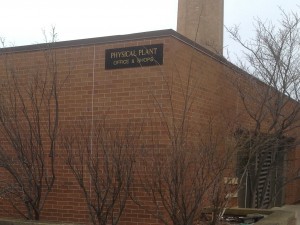St. Thomas is Xcel Energy’s largest Windsource program customer, receiving 82 percent of its electricity from wind power despite not having a turbine on campus.
Xcel Energy will award St. Thomas Thursday for its extensive use of wind energy. According to Paul Lorah, associate geography professor, the university pays Xcel Energy extra money to get power from wind. That extra money goes toward building more turbines that the Windsource program builds.
“When you look at the number of turbines they have for this program and the amount of money we’ve paid, it looks like we’re responsible for at least one, two or three wind turbines on the ground,” Lorah said.

Participation in the Windsource program is part of the university’s climate action plan, and St. Thomas established in 2008 that its goal is to be carbon neutral by 2035.
“This climate action plan tells us how we’re going to go about carbon neutrality,” Lorah said. “That’s one of the motivating factors.”
The university’s climate action plan also established a campus sustainability fund. Lorah said the university puts in $50,000 per year. The money is used to fund other sustainability projects and grants proposed by students.
St. Thomas will also be part of “The Princeton Review’s Guide to 322 Green Colleges: 2013 Edition.” An email from The Princeton Review stated that it chose the 322 schools for this guide based on the “Green Rating” scores it tallied for the schools in 2012.
“Our Green Rating is a score from 60-99 that we tally using data from a 50-question survey we conduct among hundreds of school administrators each year about their school’s environmental and sustainability-related policies, practices and academic offerings,” an email from Alyssa Wolff, The Princeton Review editorial coordinator, stated.
Freshman Ryan Burke said he is glad St. Thomas is committed to sustainable energy, but that there is much more work to do.
“I think it’s great that St. Thomas is leading the way in this especially being the largest contributor,” Burke said. “It speaks a lot about the campus and its values, but I think it also there’s so much more we could do … to be more off the grid.”
St. Thomas also placed 117th out of the 273 schools in the 2013 RecycleMania competition, recycling 30.48 lbs. per capita. St. Thomas came in second among the Minnesota schools entered in the competition to Minneapolis College of Art and Design, which ranked 26th.
St. Thomas landed its final spot in the competition after sitting 120th in early March.
Burke said he hopes St. Thomas will invest in solar panels, though Lorah said there is not enough roof space for that to be realistic.
“We don’t have enough roof space to power ourselves completely with solar … we’re in a city so we’re not gonna have a large turbine … so working with excel to get wind power from efficient large scale farms is probably a good way to go,” Lorah said.
Senior Joseph Mueller said he is happy with St. Thomas’ efforts to be a sustainable campus.
“I am proud of St. Thomas for willfully choosing to use renewable and clean energy to power the campus,” Mueller said. “It would be great to see St. Thomas large financial resources used to make the school a leader in energy.”
Grace Pastoor can be reached at past6138@stthomas.edu.

